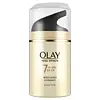What's inside
What's inside
 Key Ingredients
Key Ingredients

 Benefits
Benefits

 Concerns
Concerns

 Ingredients Side-by-side
Ingredients Side-by-side

Water
Skin ConditioningGlycerin
HumectantNiacinamide
SmoothingIsohexadecane
EmollientDimethicone
EmollientIsopropyl Isostearate
EmollientStearyl Alcohol
EmollientPanthenol
Skin ConditioningTocopheryl Acetate
AntioxidantSodium Ascorbyl Phosphate
AntioxidantRetinyl Propionate
Skin ConditioningCamellia Sinensis Leaf Extract
AntimicrobialBHT
AntioxidantC13-14 Isoparaffin
EmollientCaprylyl Glycol
EmollientDimethiconol
EmollientLaureth-7
EmulsifyingCetearyl Glucoside
EmulsifyingCetearyl Alcohol
EmollientStearic Acid
CleansingPalmitic Acid
EmollientCetyl Alcohol
EmollientBehenyl Alcohol
EmollientDisodium EDTA
Polyacrylamide
PEG-100 Stearate
Titanium Dioxide
Cosmetic Colorant1,2-Hexanediol
Skin ConditioningPhenoxyethanol
PreservativeParfum
MaskingCI 19140
Cosmetic ColorantCI 16035
Cosmetic ColorantWater, Glycerin, Niacinamide, Isohexadecane, Dimethicone, Isopropyl Isostearate, Stearyl Alcohol, Panthenol, Tocopheryl Acetate, Sodium Ascorbyl Phosphate, Retinyl Propionate, Camellia Sinensis Leaf Extract, BHT, C13-14 Isoparaffin, Caprylyl Glycol, Dimethiconol, Laureth-7, Cetearyl Glucoside, Cetearyl Alcohol, Stearic Acid, Palmitic Acid, Cetyl Alcohol, Behenyl Alcohol, Disodium EDTA, Polyacrylamide, PEG-100 Stearate, Titanium Dioxide, 1,2-Hexanediol, Phenoxyethanol, Parfum, CI 19140, CI 16035
Water
Skin ConditioningGlycerin
HumectantCaprylyl Methicone
Skin ConditioningButylene Glycol
HumectantAlcohol Denat.
AntimicrobialDimethicone
EmollientIsododecane
EmollientPEG-10 Dimethicone
Skin ConditioningDipropylene Glycol
HumectantPrunus Amygdalus Dulcis Seed Extract
Skin ConditioningCucumis Melo Fruit Extract
Skin ConditioningPersea Gratissima Oil
Skin ConditioningSaccharomyces Lysate Extract
HumectantAcetyl Glucosamine
Skin ConditioningPorphyridium Cruentum Extract
Skin ConditioningDipeptide Diaminobutyroyl Benzylamide Diacetate
Skin ConditioningAcetyl Hexapeptide-8
HumectantPalmitoyl Tetrapeptide-7
Skin ConditioningAcetyl Octapeptide-3
HumectantCholesterol
EmollientDecarboxy Carnosine Hcl
Skin ConditioningAcetyl Carnitine Hcl
Skin ConditioningCaffeine
Skin ConditioningCreatine
Skin ConditioningSigesbeckia Orientalis Extract
Skin ConditioningPalmitoyl Tripeptide-1
Skin ConditioningPolygonum Cuspidatum Root Extract
AntioxidantCentella Asiatica Extract
CleansingGlycine Soja Protein
EmulsifyingErgothioneine
AntioxidantPropylene Glycol Dicaprylate
EmollientPEG-150
HumectantLauryl PEG-9 Polydimethylsiloxyethyl Dimethicone
Skin ConditioningJojoba Esters
EmollientLactis Proteinum
Skin ConditioningAdenosine Phosphate
Skin ConditioningTocopheryl Acetate
AntioxidantLactic Acid
BufferingYeast Extract
Skin ConditioningLinoleic Acid
CleansingSodium Hyaluronate
HumectantPhytantriol
HumectantGlycine Soja Seed Extract
Skin ConditioningDisteardimonium Hectorite
StabilisingPropylene Carbonate
SolventMenthanediol
Skin ConditioningHydroxypropyl Methylcellulose
Emulsion StabilisingPullulan
Polyquaternium-51
Skin ConditioningSodium Hydroxide
BufferingCalcium Chloride
AstringentCarbomer
Emulsion StabilisingSea Whip Extract
Skin ConditioningPolysorbate 20
EmulsifyingCaprylyl Glycol
EmollientTetrahexyldecyl Ascorbate
AntioxidantCitric Acid
BufferingPotassium Sulfate
Sodium Hexametaphosphate
MaskingSodium Citrate
BufferingPotassium Sorbate
PreservativeSodium Benzoate
MaskingPhenoxyethanol
PreservativeWater, Glycerin, Caprylyl Methicone, Butylene Glycol, Alcohol Denat., Dimethicone, Isododecane, PEG-10 Dimethicone, Dipropylene Glycol, Prunus Amygdalus Dulcis Seed Extract, Cucumis Melo Fruit Extract, Persea Gratissima Oil, Saccharomyces Lysate Extract, Acetyl Glucosamine, Porphyridium Cruentum Extract, Dipeptide Diaminobutyroyl Benzylamide Diacetate, Acetyl Hexapeptide-8, Palmitoyl Tetrapeptide-7, Acetyl Octapeptide-3, Cholesterol, Decarboxy Carnosine Hcl, Acetyl Carnitine Hcl, Caffeine, Creatine, Sigesbeckia Orientalis Extract, Palmitoyl Tripeptide-1, Polygonum Cuspidatum Root Extract, Centella Asiatica Extract, Glycine Soja Protein, Ergothioneine, Propylene Glycol Dicaprylate, PEG-150, Lauryl PEG-9 Polydimethylsiloxyethyl Dimethicone, Jojoba Esters, Lactis Proteinum, Adenosine Phosphate, Tocopheryl Acetate, Lactic Acid, Yeast Extract, Linoleic Acid, Sodium Hyaluronate, Phytantriol, Glycine Soja Seed Extract, Disteardimonium Hectorite, Propylene Carbonate, Menthanediol, Hydroxypropyl Methylcellulose, Pullulan, Polyquaternium-51, Sodium Hydroxide, Calcium Chloride, Carbomer, Sea Whip Extract, Polysorbate 20, Caprylyl Glycol, Tetrahexyldecyl Ascorbate, Citric Acid, Potassium Sulfate, Sodium Hexametaphosphate, Sodium Citrate, Potassium Sorbate, Sodium Benzoate, Phenoxyethanol
Ingredients Explained
These ingredients are found in both products.
Ingredients higher up in an ingredient list are typically present in a larger amount.
Caprylyl Glycol is a humectant and emollient, meaning it attracts and preserves moisture.
It is a common ingredient in many products, especially those designed to hydrate skin. The primary benefits are retaining moisture, skin softening, and promoting a healthy skin barrier.
Though Caprylyl Glycol is an alcohol derived from fatty acids, it is not the kind that can dry out skin.
This ingredient is also used as a preservative to extend the life of products. It has slight antimicrobial properties.
Learn more about Caprylyl GlycolDimethicone is a type of synthetic silicone created from natural materials such as quartz.
What it does:
Dimethicone comes in different viscosities:
Depending on the viscosity, dimethicone has different properties.
Ingredients lists don't always show which type is used, so we recommend reaching out to the brand if you have questions about the viscosity.
This ingredient is unlikely to cause irritation because it does not get absorbed into skin. However, people with silicone allergies should be careful about using this ingredient.
Note: Dimethicone may contribute to pilling. This is because it is not oil or water soluble, so pilling may occur when layered with products. When mixed with heavy oils in a formula, the outcome is also quite greasy.
Learn more about DimethiconeGlycerin is already naturally found in your skin. It helps moisturize and protect your skin.
A study from 2016 found glycerin to be more effective as a humectant than AHAs and hyaluronic acid.
As a humectant, it helps the skin stay hydrated by pulling moisture to your skin. The low molecular weight of glycerin allows it to pull moisture into the deeper layers of your skin.
Hydrated skin improves your skin barrier; Your skin barrier helps protect against irritants and bacteria.
Glycerin has also been found to have antimicrobial and antiviral properties. Due to these properties, glycerin is often used in wound and burn treatments.
In cosmetics, glycerin is usually derived from plants such as soybean or palm. However, it can also be sourced from animals, such as tallow or animal fat.
This ingredient is organic, colorless, odorless, and non-toxic.
Glycerin is the name for this ingredient in American English. British English uses Glycerol/Glycerine.
Learn more about GlycerinPhenoxyethanol is a preservative that has germicide, antimicrobial, and aromatic properties. Studies show that phenoxyethanol can prevent microbial growth. By itself, it has a scent that is similar to that of a rose.
It's often used in formulations along with Caprylyl Glycol to preserve the shelf life of products.
Tocopheryl Acetate is AKA Vitamin E. It is an antioxidant and protects your skin from free radicals. Free radicals damage the skin by breaking down collagen.
One study found using Tocopheryl Acetate with Vitamin C decreased the number of sunburned cells.
Tocopheryl Acetate is commonly found in both skincare and dietary supplements.
Learn more about Tocopheryl AcetateWater. It's the most common cosmetic ingredient of all. You'll usually see it at the top of ingredient lists, meaning that it makes up the largest part of the product.
So why is it so popular? Water most often acts as a solvent - this means that it helps dissolve other ingredients into the formulation.
You'll also recognize water as that liquid we all need to stay alive. If you see this, drink a glass of water. Stay hydrated!
Learn more about Water